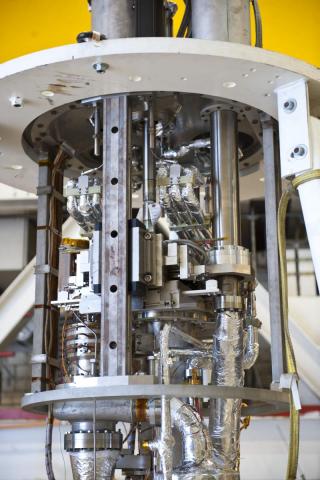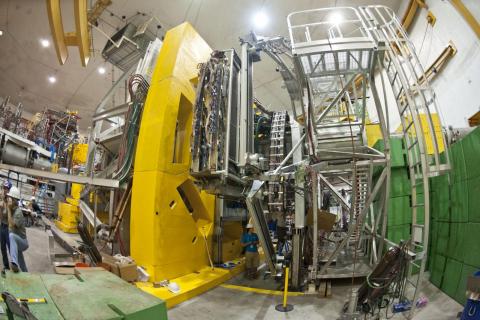

An international team including Canadian researchers at the University of Manitoba, University of Winnipeg, University of Northern British Columbia, and TRIUMF has reported first results for the proton’s weak charge in Physical Review Letters (to appear in the October 18, 2013 issue) based on precise new data from Jefferson Laboratory, the premier U.S. electron-beam facility for nuclear and particle-physics research in Newport News, VA.
The Q-weak experiment used a high-energy electron beam to measure the weak charge of the proton – a fundamental property that sets the scale of its interactions via the weak nuclear force. This is distinct from but analogous to its more familiar electric charge (Q) – hence, the experiment’s name: `Q-weak’. Following a decade of design and construction, Q-weak had a successful experimental run in 2010-12 in Hall C at Jefferson Laboratory. Data analysis has been underway ever since.
“Nobody has ever attempted a measurement of the proton’s weak charge before,” says Roger Carlini, Q-weak’s spokesperson at Jefferson Laboratory, “due to the extreme technical challenges to reach the required sensitivity. The first 4% of the data have now been fully analyzed and already have an important scientific impact, although the ultimate sensitivity awaits analysis of the complete experiment.”
The first result, based on Q-weak’s commissioning data set, is 0.064 ± 0.012. This is in good agreement with the theoretical prediction of 0.0710 ± 0.0007 based on our current understanding of fundamental interactions, which physicists refer to as the Standard Model.
In order to measure the proton’s weak charge, experimenters had to exploit the weak interaction’s unique property of parity violation, closely related to mirror symmetry. The Q-weak collaboration built an apparatus to detect the scattered electrons with unprecedented sensitivity, allowing them to measure the tiny asymmetry in the electron scattering rate that depends on the longitudinal polarization of the electron beam. The success of the experiment relied on Jefferson Laboratory’s world renowned ‘parity quality’ beam properties. When the spin of the beam particles is reversed with respect to their direction of motion, the changes to its other properties can be kept amazingly small -- for example, the beam moves less than the width of an atom, on average.
To achieve the required statistical precision for Q-weak, the CEBAF accelerator at Jefferson Laboratory was pushed to new limits of high intensity polarized beam delivery, and the liquid hydrogen (proton) target built for Q-weak was able to absorb 1.7 kW of beam power while maintaining uniform density at a temperature of only 20 degrees above absolute zero, making it the world’s highest power liquid hydrogen target to date. The apparatus contained many interleaved diagnostic systems to monitor and diagnose beam conditions during data taking. All of these systems worked extremely well, as demonstrated by the first results reported here.
The Canadian group has played a leading role in the Q-weak experiment since its inception – a proposal submitted to Jefferson Laboratory’s Program Advisory Committee 12 years ago. Dr. Shelley Page (U. Manitoba) is a co-spokesperson for Q-weak; Dr. Willem T.H van Oers led the construction of the large magnetic spectrometer for Q-Weak in collaboration with scientists and engineers from TRIUMF, the University of Manitoba, MIT-Bates Laboratory, and Jefferson Laboratory. Dr. Willie Falk (U. Manitoba) led the design of the magnetic field for the spectrometer; Q-weak main detector development and testing was carried out in Dr. Michael Gericke’s CFI-funded lab at the U. of M., while Dr. Jim Birchall (U. Manitoba) spearheaded efforts to model systematic errors for the experiment. Three Ph.D. theses, and the focussed activity of a team of postdoctoral research associates and numerous undergraduate summer research students all contributed to the Canadian group’s efforts. A novel diamond strip electron detector for the Hall C Compton polarimeter was developed in Dr. Jeff Martin’s lab a the University of Winnipeg. In all, the Canadian group contributed about 15% of the Q-weak effort in terms of manpower and resources, focused on design and construction of the experimental apparatus, planning and execution of the measurements, and analysis of the data. Extending a successful design that was developed for the TRIUMF proton-proton parity violation experiment (TRIUMF E497), essentially all of the low noise integrating electronics used for Q-weak were built at TRIUMF, including readout of the new Compton polarimeter detectors. Over the years, more than $3M of NSERC support has been provided through the subatomic physics Project Grant program to the Canadian group (which also includes scientists from the University of Winnipeg, University of Northern BC, and TRIUMF) – funds were used to build equipment and support student and postdoctoral researchers’ salaries and travel to carry out the measurements at Jefferson Laboratory.
The really great news is that Q-weak has about 25 times more data in hand, which is currently undergoing analysis. This will allow experimenters to further shrink the error bar, which will then be small enough to severely constrain possible physics beyond the Standard Model. The final result could reveal hints of new interaction-mediating particles, and would be complementary to searches at the highest energy scales such as at the Large Hadron Collider project in Geneva, Switzerland.
This first determination of the proton’s weak charge was carried out by a team of 97 researchers from 23 institutions in the US, Canada, and Europe. It was made possible by funding from the US Department of Energy and the US National Science Foundation, the Natural Sciences and Engineering Research Council of Canada, university matching contributions from The College of William and Mary, Virginia Tech, George Washington University, and Louisiana Tech University, and technical and engineering support from Jefferson Laboratory, TRIUMF (Canada), and MIT-Bates laboratories.
Stay tuned for updates on the Q-weak experiment as analysis of the full data set is completed!
-- by S.A. Page and W.T.H. van Oers (Univ of Manitoba), based on Qweak Collaboration press release
